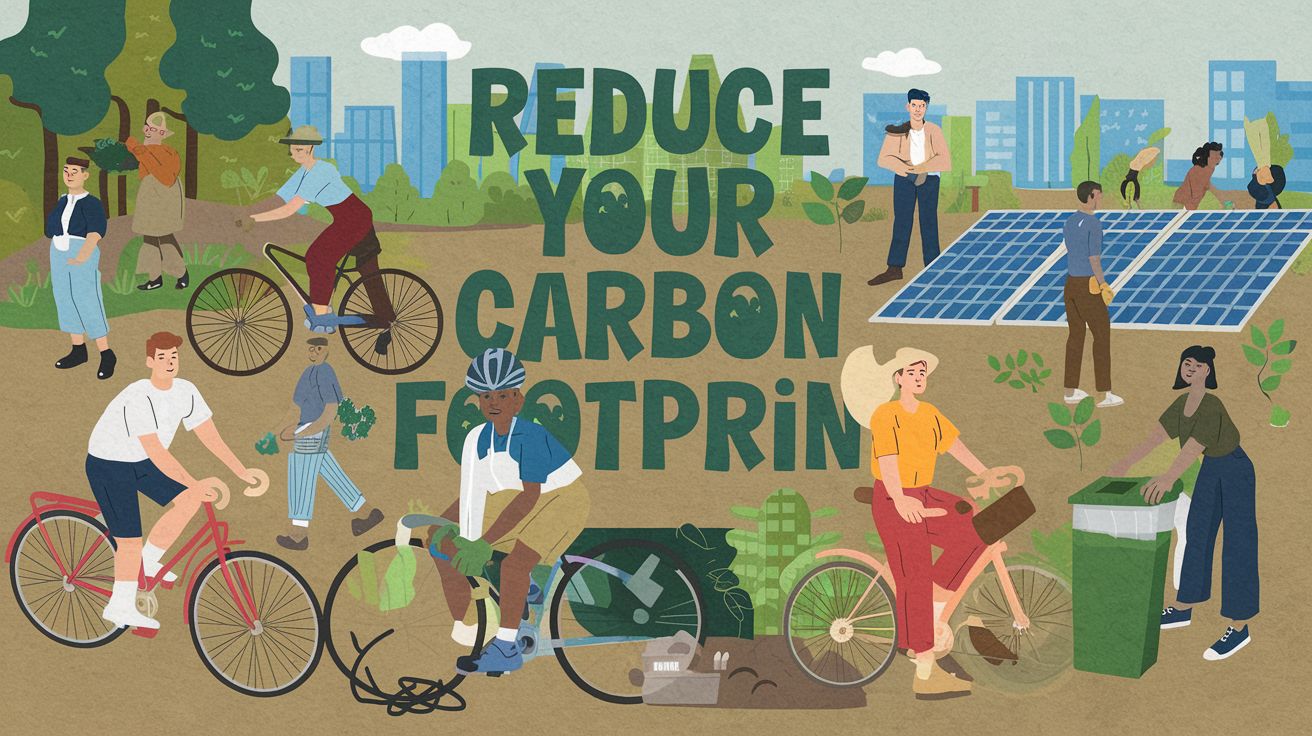Are you ready to make a real difference in the fight against climate change? 🌍 You might think that reducing your carbon footprint is a daunting task, but the truth is, it’s easier than you think! Small changes in our daily lives can add up to a significant impact on the environment.
From the way we commute to how we manage our homes and consume resources, there are countless opportunities to shrink our carbon footprint. The best part? Many of these changes not only benefit the planet but can also save you money and improve your quality of life. It’s a win-win situation!
In this blog post, we’ll explore five simple yet effective ways to reduce your carbon footprint. We’ll cover eco-friendly transportation choices, energy-efficient home improvements, mindful consumption habits, water conservation techniques, and waste reduction strategies. By the end, you’ll be equipped with practical tips to start making a positive change today. Let’s dive in and discover how easy it can be to live a more sustainable life! 🌱
Eco-Friendly Transportation Choices
Embrace Public Transit
Public transportation is a powerful tool in reducing your carbon footprint. By choosing buses, trains, or subways over personal vehicles, you can significantly decrease your individual emissions.
Benefits of public transit:
- Reduced carbon emissions per passenger
- Less traffic congestion
- Cost-effective for daily commutes
- Opportunity to relax or be productive during travel
| Mode of Transport | CO2 Emissions (g/passenger/km) |
|---|---|
| Bus | 68 |
| Train | 14 |
| Car (single occupant) | 171 |
Cycle or Walk for Short Trips
For distances under 5 kilometers, consider cycling or walking. These zero-emission options offer multiple benefits:
- Improved physical health and fitness
- No fuel costs
- Reduced road congestion
- Enjoyment of your surroundings
Carpool with Colleagues
Sharing rides to work or social events can drastically cut down on emissions. Carpooling advantages include:
- Reduced fuel consumption per person
- Lower parking fees when split among passengers
- Use of high-occupancy vehicle (HOV) lanes
- Social interaction and networking opportunities
Consider Electric Vehicles
If public transit or non-motorized options aren’t feasible, electric vehicles (EVs) offer a greener alternative to traditional cars. EVs produce zero direct emissions and are becoming increasingly accessible. Key points:
- Lower operating costs compared to gas-powered vehicles
- Reduced dependence on fossil fuels
- Improved air quality in urban areas
- Growing network of charging stations
By adopting these eco-friendly transportation choices, you can make a significant impact on reducing your carbon footprint. As we explore further, we’ll see how making changes at home can complement these efforts in creating a more sustainable lifestyle.
Energy-Efficient Home Improvements
Switch to LED Lighting
LED lighting is a game-changer for energy efficiency in homes. These bulbs use up to 75% less energy than traditional incandescent bulbs and last significantly longer. Here’s a quick comparison:
| Feature | LED Bulbs | Incandescent Bulbs |
|---|---|---|
| Energy Usage | Low | High |
| Lifespan | 25,000+ hours | 1,000-2,000 hours |
| Heat Emission | Minimal | Significant |
| Cost Savings | High | Low |
Upgrade to Energy Star Appliances
Energy Star certified appliances are designed to be more efficient without sacrificing performance. Consider replacing old appliances with Energy Star models to reduce your energy consumption and utility bills.
Improve Home Insulation
Proper insulation is crucial for maintaining a comfortable temperature in your home while reducing energy waste. Key areas to focus on include:
- Attic
- Walls
- Floors
- Windows and doors
Install a Smart Thermostat
Smart thermostats learn your schedule and preferences, automatically adjusting temperature settings for optimal comfort and efficiency. They can be controlled remotely via smartphone apps, allowing you to manage your home’s energy use even when you’re away.
Use Solar Panels
Solar panels are an excellent long-term investment for reducing your carbon footprint. While the initial cost can be high, they offer significant energy savings over time and may even allow you to sell excess energy back to the grid.
Now that we’ve explored energy-efficient home improvements, let’s move on to discuss mindful consumption habits that can further reduce your environmental impact.
Mindful Consumption Habits
Reduce Single-Use Plastics
One of the most impactful ways to reduce your carbon footprint is by minimizing single-use plastics. These items contribute significantly to pollution and require substantial energy to produce. Here are some practical steps to reduce your reliance on single-use plastics:
- Carry reusable shopping bags
- Use a refillable water bottle
- Bring your own coffee mug to cafes
- Opt for products with minimal packaging
- Choose reusable containers for food storage
Choose Local and Seasonal Foods
Selecting locally sourced and seasonal foods can dramatically decrease your carbon footprint. This practice reduces transportation emissions and supports local economies. Consider these benefits:
| Benefit | Local Foods | Imported Foods |
|---|---|---|
| Food Miles | Low | High |
| Freshness | High | Variable |
| Community Impact | Positive | Minimal |
| Carbon Footprint | Lower | Higher |
Adopt a Plant-Based Diet
Transitioning to a plant-based diet is an effective way to reduce your environmental impact. Plant-based foods generally require fewer resources to produce and result in lower greenhouse gas emissions. Try these strategies:
- Start with meat-free Mondays
- Experiment with plant-based protein sources
- Gradually increase the proportion of plant-based meals in your diet
Shop Second-Hand
Embracing second-hand shopping is an excellent way to reduce waste and conserve resources. By giving pre-owned items a new life, you’re helping to decrease demand for new products and their associated carbon emissions. Explore various second-hand options:
- Thrift stores
- Online marketplaces
- Consignment shops
- Swap meets or clothing exchanges
By implementing these mindful consumption habits, you’ll be well on your way to significantly reducing your carbon footprint. Next, we’ll explore water conservation techniques that can further enhance your eco-friendly lifestyle.
Water Conservation Techniques
Fix Leaky Faucets
A single dripping faucet can waste gallons of water over time. Addressing this issue is a simple yet effective way to conserve water. Here’s a quick guide to fixing leaky faucets:
- Identify the type of faucet (compression, cartridge, ball, or ceramic-disk)
- Turn off the water supply
- Remove the faucet handle and stem
- Replace worn-out washers or O-rings
- Reassemble the faucet and test for leaks
| Faucet Type | Common Issue | Typical Fix |
|---|---|---|
| Compression | Worn washer | Replace washer |
| Cartridge | Damaged cartridge | Replace cartridge |
| Ball | Worn seals or springs | Replace seals and springs |
| Ceramic-disk | Cracked disk | Replace disk |
Install Low-Flow Fixtures
Low-flow fixtures can significantly reduce water consumption without compromising functionality. Consider installing:
- Low-flow showerheads (2.5 gallons per minute or less)
- Dual-flush toilets
- Faucet aerators for kitchen and bathroom sinks
These fixtures can help you save up to 60% on water usage compared to traditional fixtures.
Collect Rainwater for Gardening
Harvesting rainwater is an eco-friendly way to maintain your garden while conserving tap water. Here’s how to get started:
- Install a rain barrel or cistern to collect roof runoff
- Use a first-flush diverter to filter out debris
- Connect the system to your garden irrigation
Rainwater is naturally soft and free from chemicals, making it ideal for plants. This method not only saves water but also reduces stormwater runoff, benefiting the local ecosystem.
Waste Reduction Strategies
Implement Composting
Composting is a simple yet effective way to reduce waste and create nutrient-rich soil for your garden. Here’s how to get started:
- Choose a composting method:
- Outdoor bin
- Indoor worm composting
- Tumbler composting
- Collect compostable materials:
- Green materials (nitrogen-rich): fruit and vegetable scraps, coffee grounds, grass clippings
- Brown materials (carbon-rich): dry leaves, paper, cardboard, wood chips
| Material Type | Examples | Benefits |
|---|---|---|
| Green | Fruit peels, vegetable scraps | Adds nitrogen, speeds decomposition |
| Brown | Dry leaves, paper | Adds carbon, provides structure |
Practice Recycling
Effective recycling is crucial for waste reduction. Follow these steps to maximize your recycling efforts:
- Learn local recycling guidelines
- Sort recyclables properly
- Clean and dry items before recycling
- Avoid contamination by removing non-recyclable parts
Embrace the 3 Rs: Reduce, Reuse, Recycle
While recycling is important, reducing and reusing should be prioritized:
- Reduce: Buy only what you need, choose products with minimal packaging
- Reuse: Repurpose items, use reusable containers and bags
- Recycle: As a last resort for items that can’t be reduced or reused
Donate Unused Items
Instead of discarding usable items, consider donating them:
- Clothing and accessories
- Furniture and home goods
- Books and electronics
- Toys and sporting equipment
By implementing these waste reduction strategies, you’ll significantly decrease your environmental impact. Next, we’ll explore how these efforts contribute to the broader goal of reducing your carbon footprint.

Reducing your carbon footprint doesn’t have to be complicated or overwhelming. By making small changes in your daily life, you can significantly impact the environment. From choosing eco-friendly transportation options and implementing energy-efficient home improvements to adopting mindful consumption habits, conserving water, and reducing waste, there are numerous ways to decrease your environmental impact.
Remember, every action counts. Start by incorporating one or two of these strategies into your routine and gradually expand your efforts. By taking these simple steps, you’ll not only reduce your carbon footprint but also inspire others to do the same, creating a ripple effect of positive change for our planet. Together, we can make a difference in the fight against climate change and build a more sustainable future for generations to come.




